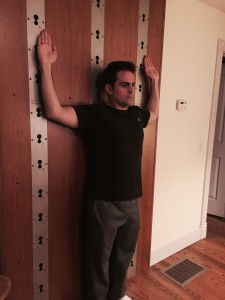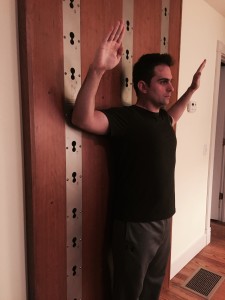Great Exercises That May Not Be Great For You: Part 2
In the previous article I went over the shoulder dumbbell press, and why it might not be the best exercise for you if you lack ROM and/or shoulder problems. The Lat Pulldown is another great exercise that can provide awesome results for the average person as well. Like the dumbbell overhead press however, you may want to reconsider doing this exercise or at least the way you do it.
Lat Pulldown
The Issue: Limited Range of Motion, Rotator Cuff Injuries
I chose to cover Lat Pulldown coming off of the dumbbell overhead press, because the two exercises are basically each other’s opposites. With the Lat Pulldown, rather than pushing up against gravity, you are pulling down. The problem, as is the case with the overhead dumbbell press, is that limited range of motion and shoulder injuries can make the exercise less than ideal for you.
In order to see if you lack range of motion to do the Lat Pulldown exercise, you can do the same shoulder ROM assessments mentioned in the first article in this series. These include the Shoulder Flexion Assessment and the Shoulder External Rotation Assessment. If you lack range of motion on either of these assessments, you may want to incorporate a regular stretching program to increase your range of motion and make the exercise safer for your shoulders.
If you have shoulder injuries or rotator cuff tears, you need to enter into the Lat Pulldown with caution. There are many muscles, tendons, and ligaments that tie into the shoulder area. When someone has an injury or problem in the shoulder region, it can be any number or problems, or a combination of problems. Some of these problems can be exacerbated by the Lat Pulldown. This is due to the nature of the motion, and the way the humerus sits in the shoulder when the arms are positioned in a way to move directly overhead when out to the side.
If after doing the Shoulder Flexion Assessment and the Shoulder External Rotation Assessment you find that you do not have sufficient range of motion to move straight overhead, there are a few modifications you may consider. This may also be appropriate if you have previous shoulder injuries that appear to be aggravated by doing the Lat Pulldown directly overhead.
First Picture: Slightly reduced range of motion directly overhead for the Shoulder Flexion Assessment
Second Picture: Highly reduced range of motion directly overhead for the Shoulder Flexion Assessment
Third Picture: Sufficient range of motion for the Shoulder External Rotation Assessment
Fourth Picture: Highly reduced range of motion for the Shoulder External Rotation Assessment
Modifications For The Lat Pulldown
First Modification: Alter The Angle Of Resistance
Many people with limited range of motion at the shoulders will find that altering the angle of resistance greatly reduces shoulder pain and problems during the movement. The way that this is done is to draw the line of resistance out in front of you more, as opposed to directly overhead. This change alone helps many people engage the lat muscles while reducing the strain on the shoulders. There are some machines that are actually designed with this principal in mind. However some people will modify the Lat Pulldown by taking a bench or preacher curl seat, and sitting out a little ways away from the line of resistance. Very often a cable crossover machine can be used to accomplish this.
Second Modification: Alter Your Palm Positioning
A lot of lifters, even those who have been working out for years, don’t fully appreciate the difference that palm positioning can play with respect to the shoulder. The Lat Pulldown exercise is typically done with the palms facing forward while pulling down the bar. A slight variation however in your palm positioning may allow you to do this exercise even if you have limited range of motion or previous shoulder injuries.
When you take your palms facing away from yourself to your palms facing in toward yourself, you are completely changing the positioning of the humerus in the shoulder. This position generally places less strain on the shoulder. When lifters performing this modification still notice pain or problems at the shoulder, very often they find that reducing the range throughout the exercise to only seventy or eight percent eliminates problems. This will not be true for everyone however, so be mindful of how you feel while making the modification. Pain is your indicator that something is not right. Additionally, this exercise will pull in more of the Biceps Brachii to aid in the lift, so it is not truly the same as a wide grip Lat Pulldown with the palms facing forward.
Third Modification: Alter The Bar Or Handle you are Using
The final modification for the Lat Pulldown that may make it more feasible for you is to alter which grip you are using to perform the exercise. In most gyms and workout facilities, there are several options that you can use for pulling types of exercises involving cables. There is of course the wide grip bar that bends at the outer end for the traditional Lat Pulldown. Additionally, there are single grip handles, shorter length bars, ropes, and handles where both hands are used simultaneously and face towards each other.
Many people with limited range of motion and/or shoulder injuries will find it helpful to use an iron handle where both hands face each other and are about three or four inches apart. This tends to place less strain on the shoulders, but still works the larger lat muscles. This can also be done with two separate handles that are attached to the cable. Again, this in combination with a reduced range of motion, and perhaps a change in the line of resistance as mentioned in the first modification, can make the Lat Pulldown feasible for many people, even with significantly reduced ROM and/or shoulder problems.
Final Thoughts
The Lat Pulldown is a great exercise. As a multi-joint exercise it targets a lot of muscles and really helps to build tone and definition particularly in the upper back. It can however be a bad idea for many people when done in the standard overhead fashion with arms wide and palms facing forward. The modifications mentioned in this article, either stand alone or combined together, can make this exercise feasible and safe for many people who otherwise should steer clear of it.
If you have shoulder injuries, make sure to meet with your doctor and a Licensed Physical Therapist. The last thing you want to do is engage in any exercises that can aggravate any existing tears or problems in the shoulder. While the above modifications are good general alterations to make the Lat Pulldown more feasible, you should always check with a medical professional if you are experiencing ongoing shoulder problems, and make sure to clarify which exercises and positions to stay away from.
Paul Owens is a personal trainer in the Cleveland area. He is a Certified Personal Trainer through the National Strength and Conditioning Association, and the National Council on Strength and fitness. He is also a Corrective Exercise Specialist through the National Academy of Sports Medicine. He can be reached at http://www.clevelandpersonaltraining.com










